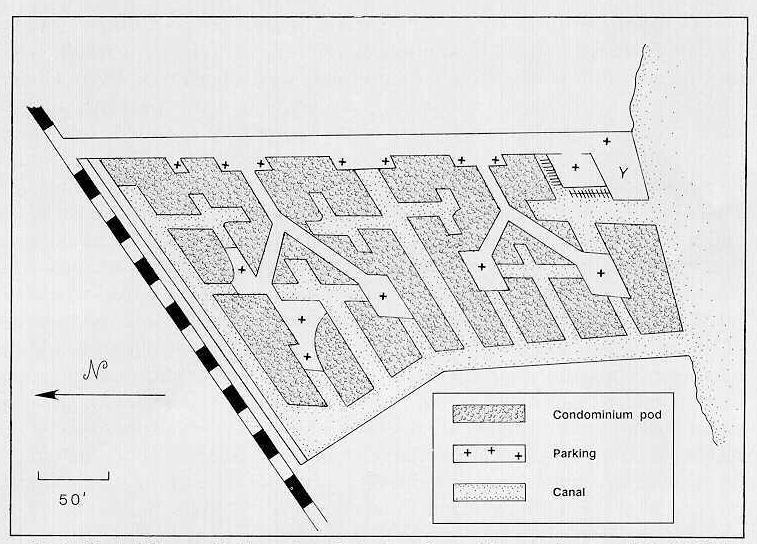| WEEK 5:
Conceptual Material: More of the MiniMax
Principle
Spatial analysis
of many forms seeks to minimize one property (or set of properties) while
maximizing another (hence, MiniMax). One sees this principle in both
conceptual and practical approaches.
-
Maximize contact between humans and natual landscapes
in a minimum of terrestrial space with minimal environmental hazard.
Viewed in the context of condos along the Great Lakes's perimeter, one
might ask how can individuals be offered the opportunity to secure desirable
shore sites without doing extensive overall damage to vast stretches of
shore line? Fractal geometry offers one solution by compressing
-
Mechanics of fractal construction

-
Characteristics of the construction as applied to condos.
-
Each condo pod has access to road on one side and shoreline on the other.
-
Both road and water networks have successively narrower routes based on
likely traffic--a hierarchy of widths
-
The two network trees are separate from each other.
-
There are no bridges required
-
Any one may have a tall-masted boat
-
Infrastructure (pipes and so forth) is not exposed
-
On



Graph Theory and Geography.
-
Graph-theoretic adjacency
1) Two nodes in a graph are adjacent if there is an edge joining them.
2) Two nodes in a digraph are adjacent if there is an arc joining them.
If there is an arc from node u to node v, u is adjacent to v and v is adjacent
from u.
3) Two edges are adjacent if they are incident with a common node.
-
Adjacency matrix
The nodes of graph theory may represent objects of
any dimension; the edges simply represent some sort of association between
those objects. Thus, graph theory theorems are very broad, general,
and universal.
More Specialized Adjacency
One might wish to take a more specialized view of
patterns of adjacency. It is interesting to consider how to use a
GIS to do so--using a bit of creative effort.
-
Dot density maps: layer of randomization, layer
of observation--scale change; absolute representation (1 dot represents
1000 people) and relative representation (1 dot represents 0.1% of the
population of the state). Use ArcView.
-
The concept of clustering is tied to scale.
-
Equal Area Projections and dot density maps--one way to look for clustering
in geographic space.
-
First, select an equal area projection (such as
an Albers Equal Area Conic for the U.S.).
-
Next, select a distribution that can usefully be represented as dot scatter--such
as population.
-
Then, choose polygonal nets of at least two different scales--such as state
and county boundaries.
-
Let the map with the smallest spatial units (counties) be used as the randomizing
layer--the dot scatter is spread around randomly
within each unit.
-
View the scatter through polygons (states) that are larger than are those
of the randomizing layer (counties). Map 1
shows
the results of removing the county boundaries; Map
2 shows the national picture with state boundaries; and, Map
3 views the dot scatter through the national border lens. The
clustering of dots at the state level means something; at the county level
it is merely random.
-
Because the underlying projection is an equal area projection, a unit square
(or other polygon) may be placed anywhere on the map and comparisons made
between one location and another. Indeed, urban or rural measures
might be held up to a value associated with similar polygon tossed out
randomly.
Reference: Mark Monmonier and Harm deBlij, How to Lie with Maps,
University of Chicago Press.
-
How are regions clustered in space? Are similar ones next to each
other or are dissimilar ones next to each other. Consider for example
some of the on-board population that comes with ArcView. Open up
the Michigan Block Group shape file. Zoom in on southeastern Michigan.
-
Go to Theme|Query; click on the little "update values" box.
Then, double click on "black" then click on > then double click on "white".
Choose "New Set". Once the selected set comes up, go to to Theme|Convert
to Shapefile. Then, color the new shapefile with a green interior
to produce this map of block groups in which quantity of
black exceeds quantity of white.
-
Go to Theme|Query; click on the little "update values" box.
Then, double click on "white" then click on > then double click on "black".
Choose "New Set". Once the selected set comes up, go to to Theme|Convert
to Shapefile. Then, color the new shapefile with a purple interior
to produce this map of block groups in which quantity of
white exceeds quantity of black.
-
A more detailed look at the clustering process might consider separating
out those block groups in which black exceeds white and has a neighboring
block group in which white exceeds black--denote this situation as BW.
There are then four logical alternatives: BW, WB, BB, and WW.
On the maps, the Ws are always purple and the Bs are always green.
A deeper shade of purple represents a block group that is itself one in
which white exceeds black and is one that has at least one neighboring
block group in which black exceeds white. To pick out the appropriate
block groups:
-
BW2: make the B layer active.
In ArcView 3.2: Go to Theme|Select by Theme. In the top pull-down,
select "are within distance of"; in the next pull down, select the W layer.
Then, for selection distance, choose 0 mi. Choose "new set".
When the selected polygons come up, convert them to a shape file and color
it a deeper green. This process will pick out the edge of the B layer
that is adjacent to the W layer.
-
WB2: make the W layer active.
Go to Theme|Select by Theme. In the top pull-down, select "are
within distance of"; in the next pull down, select the B layer. Then,
for selection distance, choose 0 mi. Choose "new set". When
the selected polygons come up, convert them to a shape file and color it
a deeper purple. This process will pick out the edge of the W layer
that is adjacent to the B layer.
-
Look at the whole map. Clustering of like
groups is evident in the Detroit metro area--similar groups are clustered.
In Washtenaw county some dissimilar groups are clustered, some are not.
Clustering of either similar or dissimilar groups is highest in Detroit--this
would fit with field evidence. This process can be iterated indefinitely
(limited by the size of the base file) and creates yet another sort of
"contouring".
-
In terms of simple Medelian conditions, each of the four conditions,
BB, BW, WB, WW would be expected, with no constraints, to occur 25% of
the time.
-
When all the block group outline boundaries are removed from the different
colors, it is easy to look at a map of the whole
state.
-
Policy makers and municipal authorities may find maps such as these useful.
-
Academic research may modify how to interpret what the adjacencies mean
and what sort of quantitative significance to assign to them; it may also
consider definitional matters, such as how polygons are adjacent--at corners
only, at edges only, or at corners and edges. Chess analogies are
often-used jargon to describe such pattern. The subject of "spatial
statistics" delves more deeply into different measures for clustering and
for levels of significance once clustering is found.
Useful extension: go to www.usgs.gov and search the site for "spatial
tools" and for "animal movement." These tools are free and are run
along with Spatial Analyst Extension to ArcView. |


